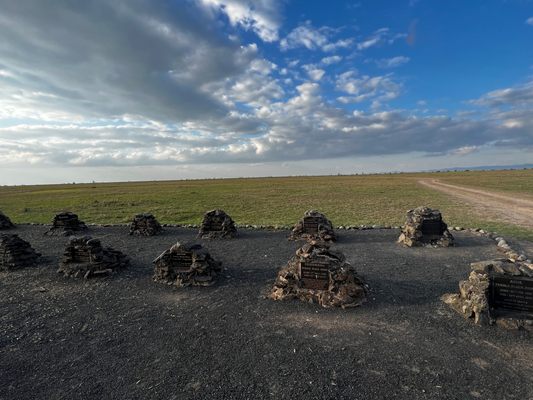About
The Rhino Cemetery of the Ol Pejeta Conservancy in Nanyuki, Kenya, might be one of the loveliest and saddest places on Earth.
Sixteen gravestones in two neat rows lay beneath a solitary acacia tree on the windswept savannah of the Ol Pejeta wildlife sanctuary. Each grave represents a rhinoceros killed by poachers on Conservancy property since its founding in 2004. The grave markers are stone cairns, and the front of each cairn holds a bronze plaque that bears the Rhino's name, gender and species, dates, and the circumstances of their death. The Rhino Cemetery was established in 2014 and fittingly opened on September 22: World Rhino Day.
The illegal trafficking of rhinoceros horn, incorrectly believed to have value as a medicine and aphrodisiac, threatens the animals' survival worldwide. The grave markers illustrate the horrors of poaching. For example, a 20-year-old female black rhino, Ishirini, was found on February 22, 2016, bleeding and writhing in pain from being shot with poisoned arrows. Both her horns had been cut off her still living body. She was 12 months pregnant at the time of her death. Max, a six-year-old male black rhino, was killed despite being dehorned as protection from poaching. The poachers removed his small, regrowing horn nubs. There are similar stories for each of the murdered rhinos.
Additionally, the Cemetery contains the graves of four rhinoceros whose lives and histories were significant to Ol Pejeta and who became ambassadors for their species. Especially poignant is the grave of Sudan, the last known male Northern white rhinoceros. In December 2009, Sudan was moved from the Dvůr Králové Zoo in the Czech Republic to the Ol Pejeta Conservancy for a "Last Chance to Survive" breeding program. Accompanying him were Suni, another male, as well as Sudan's daughter, Najin, and his granddaughter, Fatu. The four rhinos were the last known members of their subspecies which had been decimated by poaching, habitat loss, and civil war. Unfortunately, attempts to breed the rhinos in Kenya were unsuccessful. Preceded in death by Suni, Sudan succumbed to the infirmities of old age on March 19, 2018, and his death made worldwide headlines. He was 45.
At the time of Sudan's death, the Northern white rhino subspecies became functionally extinct. Mother and daughter, Najin and Fatu, are the last known surviving Northern white rhinos, and can no longer bear offspring. However, some hope for their subspecies remains. Using IVF procedures, scientists successfully created embryos from fresh eggs collected from Najin and Fatu and frozen sperm from deceased males. They hope to successfully implant the embryos in Southern white rhinos who will carry them as surrogate mothers. The last remaining Northern white rhinos can be visited in their compound at Ol Pejeta, where their keepers and armed guards protect them day and night.
Ol Pejeta Conservancy was founded in 2004 as a not-for-profit wildlife sanctuary. The property is situated on the Equator in central Kenya and encompasses 140 square miles. Originally established as a sanctuary for the endangered Black Rhino, the Conservancy is home to Africa's "Big Five," as well as dozens of common and endangered animal and bird species. In 2014, Ol Pejeta was designated a "Key 1" sanctuary for black rhinos upon the birth of its 100th calf. The Conservancy is also home to the Sweetwaters Chimpanzee Sanctuary, founded in partnership with the Jane Goodall Institute and established as a lifetime refuge for orphaned and abused chimpanzees.
Related Tags
Know Before You Go
If you're coming from Nairobi, the drive is about 3 to 4 hours.
Entry fees can be paid online. Activities and campsites can be booked online, too. Ol Pejeta Conservancy can be visited during any season but for visitors who are driving themselves, a 4x4 is necessary during the rainy season.
Published
February 17, 2023






































